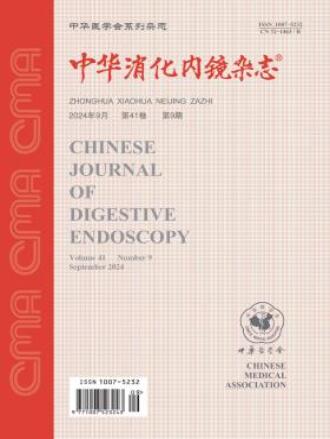Clinical value of endoscopic retrograde pancreatic drainage for pancreatic fistula
引用次数: 0
Abstract
Objective To evaluate the clinical value of endoscopic retrograde pancreatic drainage (ERPD) in patients with pancreatic fistula. Methods Data of 42 patients with pancreatic fistula, who were treated with ERPD at Changhai Hospital and Henan Provincial People's Hospital from June 2013 to September 2018, were collected. The pancreatic fistula curative rate, healing duration of pancreatic fistula, and the incidence of complications were analyzed. Results Among 42 patients with pancreatic fistula, there were 30 males (71.4%) and 12 females (28.6%) with mean age of 41.5±12.8 years old. Pancreatic duct stents of 37 cases (88.1%) went across the fistula. The overall curative rate was 90.5% (38/42) . The median healing duration of pancreatic fistula was 32.0 d (8-183 d) . The healing time of pancreatic fistula after injury (19.0±9.9 d, t=3.50, P=0.002) and of pancreatic fistula after surgery (20.3±10.7 d, t=3.35, P=0.003) were shorter than that of pancreatic fistula after acute severe pancreatitis (60.0±48.6 d) . The healing time of pancreatic fistula with pancreatic pseudocysts was longer than that of pancreatic fistula without pancreatic pseudocysts (65.3±55.4 d VS 32.6±23.6 d, t=2.21, P=0.040) . There were no significant differences in pancreatic fistula curative rate, pancreatic healing duration and times of ERCP in pancreatic fistula at different position.Postoperative stent-related complications occurred in 2 patients (4.8%) , and 1 patient (2.4%) developed mild pancreatitis. Conclusion ERPD is an important treating method with good therapeutic effect and low complications for pancreatic fistula. Key words: Stent; Pancreatic fistula; Endoscopic retrograde pancreatic drainage内镜逆行胰管引流治疗胰瘘的临床价值
目的探讨内镜下逆行胰管引流术(ERPD)治疗胰瘘的临床价值。方法收集2013年6月至2018年9月在长海医院和河南省人民医院行ERPD治疗的42例胰瘘患者的资料。分析胰瘘治愈率、胰瘘愈合时间及并发症发生率。结果42例胰瘘患者中,男性30例(71.4%),女性12例(28.6%),平均年龄41.5±12.8岁。经胰瘘置入胰管支架37例(88.1%)。总治愈率为90.5%(38/42)。胰瘘平均愈合时间为32.0 d (8 ~ 183 d)。损伤后胰瘘愈合时间(19.0±9.9 d, t=3.50, P=0.002)和手术后胰瘘愈合时间(20.3±10.7 d, t=3.35, P=0.003)均短于急性重症胰腺炎后胰瘘愈合时间(60.0±48.6 d)。合并胰腺假性囊肿的胰瘘愈合时间较不合并胰腺假性囊肿的胰瘘愈合时间长(65.3±55.4 d VS 32.6±23.6 d, t=2.21, P=0.040)。胰瘘治愈率、胰腺愈合时间及不同部位胰瘘ERCP次数差异无统计学意义。术后支架相关并发症2例(4.8%),1例(2.4%)发生轻度胰腺炎。结论ERPD治疗胰瘘疗效好,并发症少,是治疗胰瘘的重要方法。关键词:支架;胰瘘;内镜下逆行胰引流
本文章由计算机程序翻译,如有差异,请以英文原文为准。
求助全文
约1分钟内获得全文
求助全文
来源期刊
CiteScore
0.10
自引率
0.00%
发文量
7555
期刊介绍:
Chinese Journal of Digestive Endoscopy is a high-level medical academic journal specializing in digestive endoscopy, which was renamed Chinese Journal of Digestive Endoscopy in August 1996 from Endoscopy.
Chinese Journal of Digestive Endoscopy mainly reports the leading scientific research results of esophagoscopy, gastroscopy, duodenoscopy, choledochoscopy, laparoscopy, colorectoscopy, small enteroscopy, sigmoidoscopy, etc. and the progress of their equipments and technologies at home and abroad, as well as the clinical diagnosis and treatment experience.
The main columns are: treatises, abstracts of treatises, clinical reports, technical exchanges, special case reports and endoscopic complications.
The target readers are digestive system diseases and digestive endoscopy workers who are engaged in medical treatment, teaching and scientific research.
Chinese Journal of Digestive Endoscopy has been indexed by ISTIC, PKU, CSAD, WPRIM.

 求助内容:
求助内容: 应助结果提醒方式:
应助结果提醒方式:


